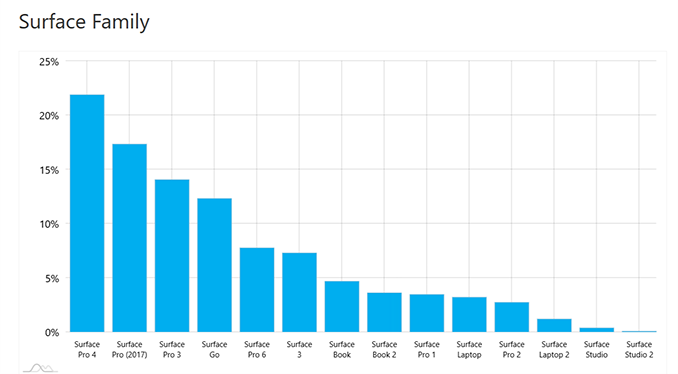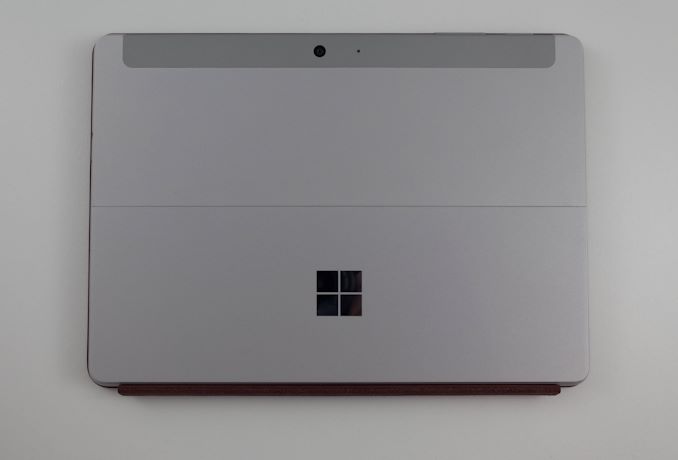The Microsoft Surface Go LTE Review: Unmatched Mobility
by Brett Howse on January 17, 2019 8:00 AM ESTFinal Words
The Surface Go sits in a somewhat interesting segment of the market. The base model has a price that’s low enough to be considered a value proposition, but like all value devices, there’s compromise to get there. The $399 starting price includes just 4 GB of RAM, and 64 GB of eMMC storage, which is outright the bare minimum that would even be usable with Windows 10. Microsoft now offers a 4 GB model with the 128 GB SSD for $499, which is already a price that’s creeping out of the value segment. 8 GB of RAM is $549, which is a lot for a low-end device. If you want to add LTE, the price starts at $679 with 8 GB of RAM and 128 GB of storage, and business customers will be able to purchase a 256 GB model as well. Then you must add in the price of the Type Cover, which starts at $99, and is realistically a required accessory.
A model with 8 GB of RAM and the Type Cover is therefore about $650, or a bit more if you choose a Signature Type Cover. That’s a lot more than the $399 get-you-in-the-door price, and really moves the Surface Go up a couple of rungs on the pricing ladder.
But the Surface Go does have some very good qualities going for it. The build quality is certainly a step above anything else in this price range on the PC side, with a fantastic magnesium body, a built-in kickstand which is every bit as good as the Surface Pro’s, and a very light weight. Even with the Type Cover attached, the device still only weighs 767 grams, or about 1.7 lbs, and coupled with the small size, makes the Surface Go extremely portable. Add in the fact that it works with the Surface Pen, and you can see an easy use case in a small, but expensive, note taking machine.
Microsoft also color calibrates all of its displays, and you would be hard pressed to find anything else in the PC space at this price range with as accurate of a display. The Go’s display isn’t the highest density one around, but at 216 pixels-per-inch, it still offers great clarity, and good contrast as well. Microsoft offers better displays on some of its other devices, but this is still a high quality display and very pleasing to use.
However, there’s some drawbacks as well. At the introductory price of $399, the underwhelming performance fits in with much of the competition, where Intel’s Atom is the name of the game. Despite Microsoft moving to a Core-based Pentium in the Surface Go, it’s disappointing to see where it stacks up: more or less even in terms of CPU performance with Intel’s latest Atom processor. At $399, that’s kind of expected, but since most people should buy the model with 8 GB of RAM, and a Type Cover, all of a sudden the Pentium Gold kind of looks out of place in a $650 PC. The performance is well above the previous non-Pro Surface 3 tablet, but the expectations have also progressed.
We’ve already touched on this, but this is a tough spot in the market for companies to try to launch quality devices for less money. Intel has a stranglehold on the market, and has taken the stance that Core branded products are sacred. Its margins must be protected. AMD doesn’t really offer anything that would compete in terms of power usage, and Qualcomm doesn’t offer anything in terms of performance. If Intel offered even a modest amount of Turbo on the Pentium Gold range, it would help tremendously, but they don’t. It’s an unfortunate spot to be in today.
The other real drawback is the battery life, which really comes down to battery capacity. At 27 Wh, there’s just no way the Surface Go can ever really be expected to provide a full day of work out of a single charge, and on a device this portable, that’s a drawback. This is why it is great to see USB-C on the Surface Go. Microsoft has never really supported this connector, but if there was a single device where it makes sense, it is this one. The Surface Connect charger is a convenient method of magnetically connecting a charger on your desk, but being able to charge off of a USB-C charger slightly mitigates the battery concerns, and would even allow a power back to be attached if necessary.
What was a great move though was coming out with this LTE model. Yes, you can always tether a laptop to a phone’s cellular connection over Wi-Fi, but for those that need something that’s always connected, that’s not the ideal solution. Having built-in LTE really expands the use cases for the Surface Go, especially in business. Having employees being able to be mobile, but still being able to manage their PCs, is an appealing draw. This is definitely not a feature everyone needs, and the $130 price increase, plus the monthly data fee, strikes that point home. But for those that need it, this is invaluable.

Source: AdDuplex.com
Despite the performance and battery life, Surface Go looks to be a bit of a hit, with a usage share already higher than many Surface devices that have been on the market longer. Clearly the small size and good build quality is something people are looking for. Adding LTE to that increases the mobility further, and although Microsoft likely won’t sell more LTE models than WI-FI, it definitely increases the potential market. And, despite the Surface Go being priced at a premium for a small form factor convertible tablet, it is still priced well under the entry level Surface Pro 6. The Pro 6 offers much higher performance, a bigger, nicer display, better battery life, and a keyboard that doesn’t feel cramped. But the Surface Go is smaller, lighter, and less expensive. With already 12% of the Surface usage share, that appears to be a winning formula.













79 Comments
View All Comments
thewishy - Thursday, January 17, 2019 - link
I've had a non-lte 8/128gb since November. I have a work Dell XPS 15, which is hugely powerful but has shockingly bad battery life and is utterly unsuited to use on a plane - so I have another machine to do heavy lifting.This machine gets used on work trips where I don't need much more than an RDP client to a lab, work, excel and OWA, and I want something to entertain me on long flights and evenings if I feel like.
It works brilliantly on the tray table in economy, the battery life might be "Poor", but with a 99wh USB-PD power pack the endurance of 16-24hrs. Given the cost and ease with which the life can be extended, 6hrs of browsing / word and 8-9 hours of movies without the power bank is reasonable IMHO. I wouldn't want to make it heavier for the sake of enhanced endurance. USB-PD charger allows me to charge phone, laptop and power bank with a single charger.
Performance is... slow. It's very noticeably less snappy than anything else I use, but doesn't crawl to a halt under load (For example, no problems with it swapping out). Under light use it's fine, and it works fine for light games.
Screen is sharp, a mouse transforms usability for office use. Keyboard is ok after a short adjustment period, but the trackpad can get in the way occasionally.
Bezel is a little large, but does make it easy to hand hold.
Lack of USB-A is a bit of a pain if you have a Yubikey, and a second USB-C would be lovely if you're using that for charging.
As my only machine it would drive me nuts, but for a specific use case it's been perfect.
TheinsanegamerN - Saturday, January 19, 2019 - link
The interior design of the Go is pathetic for battery packaging. You wouldnt have to make it thicker to fit more battery in there.Trefugl - Thursday, January 17, 2019 - link
Any idea how the CPU performance compares to the original Surface Pro (16:9 one)? I have one of those that I still use for travel, but it's definitely showing its age and the pen input isn't nearly as good as modern surface tablets, and the screens are nearly as nice either... Ideally I'm hoping that I could do some light editing of raw photos in lightroom while on the go, even if it's mildly painful... still better than trying to do it on my phone or carrying around something much bigger.Brett Howse - Thursday, January 17, 2019 - link
Hi Trefugl. I'll reference you to our Online Bench which was also linked in the article:https://www.anandtech.com/bench/product/1207?vs=23...
HStewart - Saturday, January 19, 2019 - link
I also have original Surface Pro and rarely use it - even though it performance is around i7 Y CPU.A good link to compare cpus is the following
https://cpu.userbenchmark.com/Compare/Intel-Pentiu...
It going to be really interesting to see Lakefield - it will like beat the Surface Pro 1 cpu in performance and have extreme battery life - this will be perfect for LTE companion
HStewart - Saturday, January 19, 2019 - link
Computer performance changes over time - I did use my Surface Pro 1 for photoshop and even Lightwave - but new CPU's today make a big difference.eastcoast_pete - Thursday, January 17, 2019 - link
Interesting device, somewhat overpriced. I really wish MS would go further on the mobility aspect and provide a significantly (50% bigger) larger battery. Even with 100 g more weight, it would still be light enough to carry around. Always connected shouldn't mean being plugged into an outlet after just a few hours.tmanini - Thursday, January 17, 2019 - link
"Microsoft also color calibrates all of its displays"I didn't find a handy reference article for this, so I can't confirm the statement or what exactly is done. But even if they do 'something' before it is boxed up, that calibration will drift in short order and essentially become useless. (if you plan to rely on it)
melgross - Thursday, January 17, 2019 - link
That’s not true. It used to be true in the days of the crt, but not now. Apple also calibrates all of its displays, including those in the iMac, and it’s pretty stable. That doesn’t mean that several years later it’s still perfect, but it’s pretty close, even then.The thing about these though, is that they’re just sRGB, which isn’t saying much these days.
anactoraaron - Thursday, January 17, 2019 - link
Exactly this. What exactly is the point of having a calibrated accurate display for maybe 1 month? Panels drift the most in the first year.The other thing that happens not just here at AT is these notebooks and tablets being touted as 'for image and video professionals' just because the display is accurate out of the box. This needs to stop.
Any system that lacks a display osd/hardware rgb channel/brightness/contrast adjustment isn't suited for any professional. Software can only do so much (making adjustments through Intel graphics software is awful) and for folks that absolutely need color accuracy (longer than 1 month out of the box) need the ability to adjust color channels, brightness, and contrast at the hardware level. I had a surface pro, and over time software couldn't properly calibrate it anymore. Sold it recently and went back to desktop, mobility be damned.